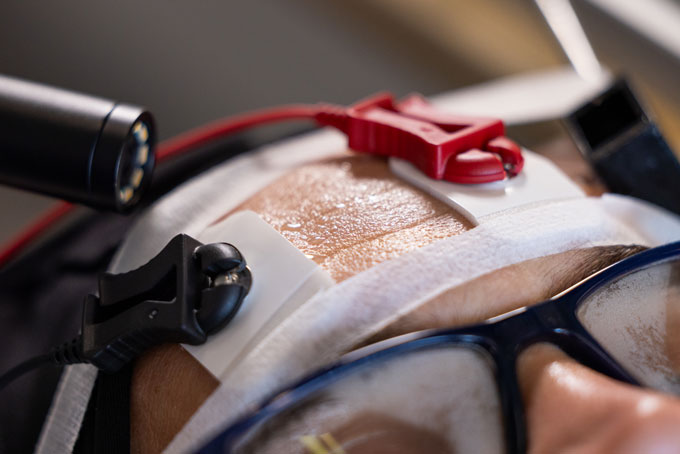Forget discrete droplets. This is how sweat really forms
Six volunteers became sweaty, overheated burritos for science

Sweat often looks at first glance like individual droplets seeping from the skin. But a new study shows the drops are an illusion, and sweat first saturates the skin, and then forms tiny, nearly flat puddles before spreading into a film.
Getty Images
It’s summer and a telltale drop of sweat tickles down your back. Next thing you know, sweat is coursing off you in rivers, and your shirt is soaked.
Now a new study, which essentially turned six people into overheated burritos for science, explains why. Contrary to common lore, sweat doesn’t just pop out of our skin as delicate droplets; instead, it rises like a tide through our pores, soaking the top layer of skin, scientists show July 23 in Journal of the Royal Society Interface. The sweat then forms a shallow pool in the pore before joining with others to make a continuous film, revealing how we go from a few prickles of sweat to suddenly sodden.
“Sweat has a bad reputation for being ‘icky’, but it is incredibly important,” says Konrad Rykaczewski, a thermal and materials engineer at Arizona State University in Tempe. The dampness itself doesn’t cool us. It’s the evaporation of the sweat that chills our skin. Studying the mechanics of sweat can help scientists develop better cooling technologies.
We often see sweat as droplets, so it’s easy to assume it forms that way. It’s “the cliché thing we picture in our heads,” says Jonathan Boreyko, who studies fluid mechanics at Virginia Tech in Blacksburg and was not involved in the study. “A very clean, hemispherical-looking droplet, kind of like just sitting on your skin that then proceeds to evaporate.”
Previous sweat studies have looked at sweat in the microscale, using light and imaging to see sweat forming in pores. They have also measured more macro-sweat. Damp skin conducts more electricity, so sweat rates can be studied with skin conductance, for example. Rykaczewski, hydration expert Stavros Kavouras and their colleagues wanted to combine the two–to look at sweat from micro to macro. “I was very surprised to find out that we did not understand the processes on a scale starting from [a] single sweat pore opening [and going up] to a few centimeters,” Rykaczewski says.

The scientists watched six volunteers sweat. Each participant rested in a recliner, wearing a full-body, tube-filled suit that can have hot or cold water run through it to warm or chill the wearer. The participants were also wrapped in heated blankets with a layer of waterproof paper in between, so they didn’t soak the blankets with sweat. The subjects were heated, cooled and heated again while the team measured every aspect of the sweat forming on their foreheads.
“It feels lovely for [the] first 15 minutes, especially in winter,” Rykaczewski says. “After about two hours, it becomes [a] bit, well, sweaty.”
Sweat forms from sweat glands in the hypodermis, the deepest skin tissue layer under the dermis and epidermis. In the first 15 minutes, heated subjects started to produce sweat, which emerged and evaporated from pores in a repeating cycle. But the sweat wasn’t in a little droplet. Instead, it was nearly flat, settling in the pore until it spilled out and connected with others, forming a puddle and then a film.
The rising tide of sweat also soaked through the stratum corneum — the outermost layer of dead skin cells — like saturating a sponge. Once the outer layer was soaked, the sweat began to pool on top. The final sweaty film quickly evaporated once the subjects were cooled, leaving behind a thin salt layer. When the heat returned, sweat rose faster than before. This time, the salt layer left behind allowed the sweat to soak more quickly into the stratum corneum, and the second sweat layer skipped the flat droplet stage entirely, coming out as a film.
“Once there is a salt layer on the stratum corneum, sweat just wicks into it, bypassing the process,” Rykaczewski says. “That is good from [an] evaporative cooling perspective, as a thin film sweat coming out of the pores covers maximum surface area for evaporation quickly.”

The scientists focused on the forehead, a place with very tiny micro hairs that help sweat evaporate. “It seems like this kind of stuff might play out wildly differently on any different part of the body,” Boreyko says. Armpits and even arms have different concentrations of sweat glands, hair and more — not to mention different potential smells.
Understanding how sweat rises and spreads could help scientists develop things like textiles to help our bodies better handle heat. Emiel DenHartog, a clothing biophysicist at North Carolina State University in Raleigh who was not involved in the study, is excited to apply the results to his work. “Currently tests on textiles are conducted with much larger droplets that may not reflect how sweat and fabrics really interact and cause cooling,” he says. “It would be exciting to connect these two areas of research.”







